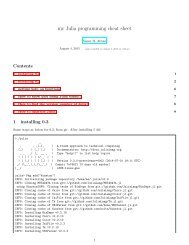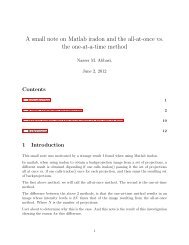You also want an ePaper? Increase the reach of your titles
YUMPU automatically turns print PDFs into web optimized ePapers that Google loves.
Hence the full solution is<br />
u p = p 0 1 ((<br />
1 − r<br />
2 )<br />
k (1 − r 2 ) 2 + (2ζr) 2 sin ϖt − 2ζr cos ϖt )<br />
u (t) = e −ξωnt (A cos ω d t + B sin ω d t) + F k<br />
Applying initial conditions now gives<br />
1<br />
(1 − r 2 ) 2 + (2ζr) 2 ((<br />
1 − r<br />
2 ) sin ϖt − 2ζr cos ϖt ) (1)<br />
A = u (0) +<br />
B = u′ (0)<br />
ω d<br />
2F rξ<br />
k<br />
1<br />
(1 − r 2 ) 2 + (2ξr) 2<br />
+ u (0) ξω n<br />
− F ( 1 − r 2) ϖ 2F rζ<br />
ω d kω d (1 − r 2 ) 2 +<br />
2<br />
+ (2ζr) kω d<br />
ω n<br />
(1 − r 2 ) 2 + (2ζr) 2<br />
The above 2 sets of equations are equivalent. One uses the phase angle explicitly and the second ones do not.<br />
Also, the above assume the force is F sin ϖt and not F cos ϖt. If the force is F cos ϖt then in Eq 1 above, the<br />
term reverse places as in<br />
u (t) = e −ξωnt (A cos ω d t + B sin ω d t) + F k<br />
Applying initial conditions now gives<br />
(<br />
1 − r<br />
2 )<br />
A = u (0) + F k (1 − r 2 ) 2 + (2ξr) 2<br />
B = u′ (0)<br />
ω d<br />
+ u (0) ξω n<br />
ω d<br />
+<br />
2F rζ<br />
kω d<br />
1 ((<br />
1 − r<br />
2 )<br />
(1 − r 2 ) 2 + (2ζr) 2 cos ϖt − 2ζr sin ϖt )<br />
ϖ<br />
(1 − r 2 ) 2 + (2ζr) 2 − F ( 1 − r 2)<br />
kω d<br />
ω n<br />
(1 − r 2 ) 2 + (2ζr) 2<br />
When a system is damped, the problem with the divide by zero when r = 1 does not occur here as was the<br />
case with undamped system, since when when ϖ ≈ ω or r = 1, the solution in Eq (1) becomes<br />
u (t) = e −ξωt ((<br />
u (0) + F k<br />
) (<br />
1<br />
u ′<br />
2ξ sin θ (0) u (0) ξω<br />
cos ω d t + + + F ω d ω d k<br />
) )<br />
1<br />
2ω d ξ (ξω sin θ − ϖ cos θ) sin ω d t<br />
+ F k<br />
1<br />
sin (ϖt − θ)<br />
2<br />
and the problem with the denominator going to zero does not show up here. The amplitude when steady state<br />
response is maximum can be found as follows. The amplitude of steady state motion is F 1<br />
k<br />
√(1−r . This<br />
2 ) 2 +(2ξr)<br />
√<br />
2<br />
1<br />
is maximum when the magnification factor β = √<br />
is maximum or when (1 − r 2 ) 2 + (2ξr) 2 or<br />
(1−r 2 ) 2 +(2ξr)<br />
√ 2<br />
(<br />
1 − ( ) )<br />
ϖ 2 2 ( )<br />
ω + 2ξ<br />
ϖ 2<br />
ω is minimum. Taking derivative w.r.t. ϖ and equating the result to zero and solving<br />
for ϖ gives<br />
ϖ = ω √ 1 − 2ξ 2<br />
We are looking for positive ϖ, hence when ϖ = ω √ 1 − 2ξ 2 the under-damped response is maximum.<br />
39





